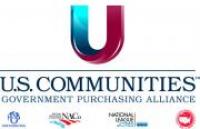When to use cooperatives
What is a cooperative contract? When should you use one? These and other questions were answered in the first of three webinars presented by U.S. Communities last month and is now available for viewing on the web.
James Foley, Deputy Chief Procurement Officer in Maricopa County, Ariz., was the keynote speaker. Chris Oltmanns, program manager for U.S. Communities, led the discussion.
Oltmanns offered an overview of cooperative purchasing organizations, and he answers, “What is a cooperative contract? A Saying his agency has used cooperative contracts for many years, Foley outlined when and when not to use one. Foley’s says his agency’s goal is to maximize the county’s buying power. He explains that even though Maricopa is the 4th largest county in the U.S., “We can’t get a better deal, say on office supplies, than some of these larger coop organizations. Sometimes it works for us to make purchases through cooperative buys.”
Foley (photo to the right) said speed is the primary reason to use coops. “The coops are already out there, and they are ready to go as opposed to us trying to develop our own solicitation process on specific products.” 
He noted that it takes his agency 30 days to complete a straight bid and 90 days to complete a standard RFP. “Add in complexities, changing requirements, etc., and a public agency could be in the marketplace from 90 to 180 days to complete the process, depending on what the need is,” Foley said.
He said that his buyers only uses coops that have a lead public agency in charge of the transaction — a lead public agency model. Foley agency, in cooperation with the Arizona Capitol Chapter of NIGP (AZNIGP) has developed a cooperative purchasing checklist.
“We go through the checklist each time we want to use a coop. Folks in the chapter have modified the checklist to their specific needs,” Foley says. “Before you do the RFP or transaction, you need to do your due-diligence. There are many coops out there — which one meets your needs?” Foley says the ProcureSource site is one resource for completing the due diligence process.
A few of the questions in the cooperative purchasing checklist include:
Will volume-pricing advantages be applied to purchases?
Are there any fees associated with use of the contract? Are they reasonable and justified?
Were local and regional vendors offered the opportunity to compete for the contracts?
Did the cooperative or lead agency have the expertise, reputation and history of quality contracting for the good or service being procured?
Was past experience with the cooperative or lead agency acceptable?
 Oltmanns said 70,000+ public agencies are registered participants of his firm’s cooperative. He explains that his firm’s advisory board bought over $168 million in products and services through the U.S. Communities cooperative program in 2014. About 30 public agencies and nonprofits are on the advisory board. U.S. Communities participants can use the board as a resource.
Oltmanns said 70,000+ public agencies are registered participants of his firm’s cooperative. He explains that his firm’s advisory board bought over $168 million in products and services through the U.S. Communities cooperative program in 2014. About 30 public agencies and nonprofits are on the advisory board. U.S. Communities participants can use the board as a resource.
The second in the webinar series, “How to Partner with Suppliers Effectively,” was held in early December and also is available online. The third, “Streamlining Purchasing Through E-Commerce,” will be presented on Janary 7. Go here for more information.
Michael Keating is Senior Editor at Government Product News, an American City & County sister brand.
_____________
To get connected and stay up-to-date with similar content from American City & County:
Like us on Facebook
Follow us on Twitter
Watch us on Youtube





















Are there other cooperatives
Are there other cooperatives besides US Communities?
Yes there are. Following are
Yes there are. Following are several government cooperatives.
NASPO/Value Point
US Communities
H-GAC (Houston-Galveston)
Keystone Purchasing Network
NJPA (National Joint Powers Alliance)
National IPA
NPP Gov (National Purchasing Partners Government Division)
TCPN (The Cooperative Purchasing Network)
TIPS (The Interlocal Purchasing System)